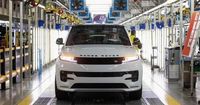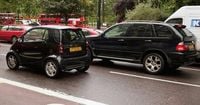London’s streets have undergone a dramatic transformation over the past two decades, with sport utility vehicles (SUVs) multiplying at a rate that has left city planners, campaigners, and parents deeply concerned. What began as a trickle of around 80,000 SUVs in 2002 has swelled to an estimated 800,000 by 2023, according to data compiled by Clean Cities and reported by BBC and The Guardian. This tenfold increase means SUVs now account for 30% of all cars in England’s cities, up from just 3% two decades ago. The implications for public safety, congestion, and the very shape of urban life are sparking heated debate—and policy responses that could reshape the future of city driving.
“SUVs increasingly dominate our streets,” said Dr. Anna Goodman, an academic transport researcher and director of Transport for Quality of Life, who worked with Clean Cities on the research. “This has important implications for congestion, public space, and road safety. The evidence is clear that SUVs increase road danger for people walking and cycling, particularly for children.”
The design features that make SUVs appealing to some—higher seating positions, bulkier frames, and a sense of security—are the same characteristics that make them problematic in cities. As Dr. Anthony Laverty of Imperial College London told BBC, “If an SUV hits a pedestrian or a cyclist they are much more dangerous and more likely to kill them. We did a review of all of the studies globally, which included half a million road traffic injuries, and that found that if you are hit by an SUV compared to being hit by a passenger car you are 44% more likely to be killed. Among kids it’s higher – it’s 82%.”
This elevated risk is not merely theoretical. The taller, blunter bonnets of SUVs mean that children are more likely to be struck in the head or torso, and in some cases, drivers cannot see small children standing directly in front of their vehicles. Tests commissioned by Transport & Environment (T&E) revealed that the driver of a Ram TRX—the highest-fronted model on EU and UK roads—could not see children up to nine years old standing in front of the vehicle. Even a Land Rover Defender driver would miss children as old as four and a half, leaving the youngest pedestrians particularly vulnerable.
Beyond safety, the sheer physical presence of SUVs is reshaping city landscapes. “In London alone, SUVs now take up as much space as an entire inner-city borough – that’s tarmac we could be using for homes, parks, or safer streets,” said Oliver Lord, UK head of Clean Cities, in comments published by The Guardian. “These oversized vehicles are not just swallowing our public space, they’re also far more dangerous, especially for children. If we want cities that are safe, breathable and accessible, we have to get serious about tackling the rise of these urban land-hogs.”
The environmental impact is also significant. SUVs, being heavier and larger, emit more pollutants and produce more toxic particles from tire wear. Their growing dominance is making it harder for cities to meet clean air targets and reduce greenhouse gas emissions.
With mounting evidence and public concern, policymakers are starting to act. Some London boroughs are considering, or have already implemented, measures to discourage SUV use. Westminster, for instance, has rolled out emissions-based parking charges, which have increased costs for certain larger vehicles. Lambeth is working with other authorities to develop similar policies, and campaigners are pushing for even broader changes.
Nicola Pastore, founder of the group Solve the School Run, told BBC London, “SUVs are really dangerous for children. I’m a parent of three kids all under nine and when we are navigating the urban area there are so many really big cars on the streets and it’s really scary as children hit by big cars are at much more risk. The really worrying thing is this issue is getting worse as more of these SUVs are getting sold every year and getting on to our streets. So it’s getting worse every year.”
Public sentiment seems to be shifting as well. Polling conducted for Clean Cities found that 59% of Londoners support higher parking charges for SUVs, and nearly six in ten are concerned that bigger cars make it more dangerous for children to walk and cycle around the capital.
Internationally, cities are already experimenting with tougher measures. In 2024, Parisians voted to triple parking rates for SUVs weighing 1.6 tonnes or more, raising the fee to €18 (£15.55) per hour in inner Paris. According to Le Parisien and The Guardian, this policy has already reduced SUV surface parking by two-thirds. Inspired by Paris, campaigners in the UK are calling for similar parking charges in major cities including Birmingham, Bristol, Cardiff, Edinburgh, Leeds, Liverpool, and Manchester.
Some local governments are exploring additional strategies. Cardiff has consulted the public on weight-based thresholds for parking charges. Edinburgh has restricted advertising for SUVs, while Bristol and Bath are examining plans to discourage SUV use. The London Assembly’s Transport Committee, chaired by Elly Baker, is urging the mayor to press for tighter regulations on vehicle size and bonnet height, a progressive tax on vehicle weight, and higher parking fees for SUVs to reflect the pressure they put on city infrastructure.
“London’s limited road space wasn’t designed for the monster vehicles we are now seeing sold,” Baker told BBC London. “SUVs are clogging up our street space, making parking difficult, and the increased bonnet height and weight increase the risk of serious injury or death in a collision. We should be placing limits on the size of normal vehicles, and exploring increased charges where appropriate.”
The political momentum is building. Lambeth Council is actively considering a parking surcharge on “supersize” cars, and Clean Cities has helped form the SUV Alliance, a coalition of 14 environmental and transport groups dedicated to tackling the issue. There is also pressure on national parties, with campaigners urging Labour to adopt European-style restrictions—such as increased parking charges and tighter size regulations—to address the growing problem.
City Hall has acknowledged the mounting concerns. A spokesperson told BBC London, “This year, the mayor will be refreshing his Vision Zero Action Plan to restate his commitment to reducing road danger and responding to new and emerging risks on our roads.”
While the Society of Motor Manufacturers and Traders declined to comment, the debate over SUVs in cities is far from over. As safety, space, and environmental concerns collide, London and other UK cities stand at a crossroads, weighing the convenience and popularity of SUVs against the urgent need to reclaim streets for people, not just cars. The outcome will shape the character of urban life for decades to come.






